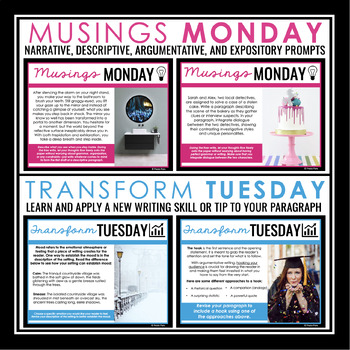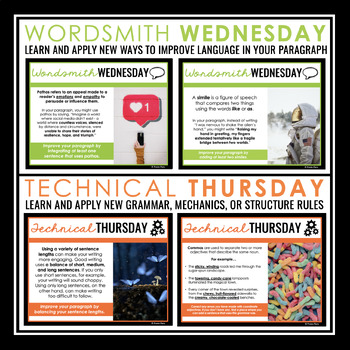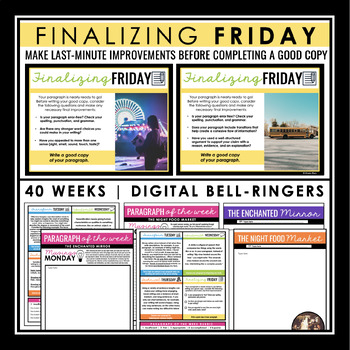Paragraph of the Week - Writing Bell Ringers for Middle High English - Digital
- Zip
- Google Apps™
- Internet Activities

What educators are saying
Also included in
- The Paragraph of the Week Writing Bell-Ringers Digital and Print Program is the most engaging way to help your students become stronger writers. These 40 weeks of standards-based writing bell ringers will ignite creativity and foster growth in argumentative, narrative, expository, and descriptive wrPrice $59.99Original Price $79.98Save $19.99
Description
The Paragraph of the Week Writing Bell-Ringers Digital Program is the most engaging way to help your students become stronger writers. These 40 weeks of standards-based writing bell ringers will ignite creativity and foster growth in argumentative, narrative, expository, and descriptive writing.
Each Monday, students will receive a thought-provoking prompt, inspiring them to craft a powerful paragraph in the style of one of the four writing types. Throughout the week, they will hone their writing skills by improving the paragraph’s language, grammar, organization, and more! This full-year resource comes with everything you need to adopt this game-changing daily routine that will dramatically improve your students’ writing skills.
This is a Google-compatible activity, and students complete all the work on a device. This works well with distance learning, 1:1 classrooms, remote teaching, Google Classroom, or for online education.
What Teachers Are Saying About the Paragraph of the Week Program:
⭐️⭐️⭐️⭐️⭐️ Another EXCELLENT package by Presto Plans. You can never go wrong with Presto resources - they are very well thought out, thorough, colourful and engaging. The weekly topics are engaging, and students appreciate the focus on a different style each week.
⭐️⭐️⭐️⭐️⭐️ This is AMAZING! I love that it is focused on specific things and that is how it is graded. It's all done for you and the students have so much flexibility within the prompt it hits all types of thinkers.
⭐️⭐️⭐️⭐️⭐️ I LOVE this resource. Each week the students are "forced" to focus on specific tasks in which they have the opportunity to practice. Well done! It has truly helped my students target skills they typically do not address.
⭐️⭐️⭐️⭐️⭐️ This is a phenomenal resource! I appreciate the intentionality behind each day's work for the week. The prompts are highly interesting for students and there really is something for everyone in the resource. This has helped me AND students.
Included in this Digital Paragraph of the Week resource:
➡️ Writing Bell Ringers Presentation: This 200-slide Google Slides presentation guides students through each of the 40 high-interest argumentative, narrative, expository, and descriptive writing prompts. There are 10 weeks devoted to each of the four writing types, and you have the option to either alternate between each of the writing types (which is how the resource is intended to be used) or focus one at a time for 10 weeks straight.
➡️ Student Response Slides: Students will use the weekly student response slides to craft their weekly paragraph. The slides include a space for their rough draft, daily tasks to improve their writing, and templates designed for students to use when writing their final versions of their paragraphs. A customized rubric is also included on the slides to assess the specific skills and standards addressed that week.
How to use this Digital Paragraph of the Week resource:
Students begin each week with one of the 40 high-interest argumentative, narrative, expository, or descriptive writing bell ringer prompts specifically chosen to relate to a writing, language, and technical skill for that week.
Start each week by providing students with the corresponding response slides with the prompt for that week. Each day, you will also show students the corresponding slide with their task for that day.
Each paragraph of the week follows the same daily structure outlined below:
- Musings Monday: Mondays are for free writing, where students let their thoughts flow freely into a rough draft without worrying about grammar, structure, etc.
- Technical Tuesday: Tuesdays are when students learn and apply a new domain-specific, standards-based writing skill to their paragraph on the rough draft slide.
- Wordsmith Wednesday: On Wednesdays, students learn and apply new ways to improve the language in their paragraph (word choice, figurative language, persuasive techniques, etc.).
- Technical Thursday: Each Thursday, students learn and apply a new technical skill to their paragraph related to grammar, mechanics, or writing structure.
- Finalizing Friday: At the end of the week, students use a short checklist to do a final review of the most important elements of the week’s writing task and complete their final paragraph!
A paragraph of the week rubric is also provided for assessment after each week, which students can also use to improve their paragraphs.
Skills are addressed in the Paragraph of the Week resource
This comprehensive program will cover nearly all of your writing and language standards. Below is a list of just some of the skills addressed:
Argument Writing
- Integrating evidence types (expert opinions, facts, statistics, testimonies)
- Writing topic sentences
- Writing concluding statements
- Writing arguments to support claims
- Opposing claims
- Organizing reasons and evidence
- Hooking the audience
- Writing a thesis statement
- Author's tone
- Persuasive language (ethos, pathos, logos)
- Formal writing style
- Transitions
- Using rhetorical questions
- and much more!
Descriptive Writing
- Imagery (smell, sight, taste, touch, sound)
- Pacing
- Atmosphere
- Figurative Language
- Strong adverbs
- Strong adjectives
- Strong verbs
- Broadness vs. specificity
- and much more!
Expository Writing
- Compare Contrast
- Cause Effect
- Problem Solution
- Procedural writing
- Autobiographies
- Travel writing
- Integrating interviews
- Fact vs. opinion
- Domain-specific language
- Formal writing
- Imagery
- Voice
- Transitions
- and much more!
Narrative Writing
- Direct vs. Indirect characterization
- Building suspense
- Integrating foreshadowing
- Establishing mood
- Developing conflict
- Using flashbacks or flashforwards
- Integrating symbolism
- Describing the setting
- Establishing a theme
- Replacing dead words
- Adding sensory language
- Developing emotions
- and much more!
Technical Writing Strategies (Grammar, Mechanics, Structure)
- Balancing sentence lengths
- Verb-tense consistency
- Formatting dialogue
- Comma rules
- Transitions in writing
- Capitalization
- Spelling
- Semi-colons
- Apostrophes
- Homophones
- Misplaced modifiers
- Parallel structure
- End punctuation
- Run-on sentences
- Fragments
- Integrating quotations
- and much more!
Looking for the print version? Click here.
© Presto Plans
➡️ Want 10 free ELA resources sent to your inbox? Click here!
⭐️ Follow Presto Plans on TpT to see what's new and on sale!






